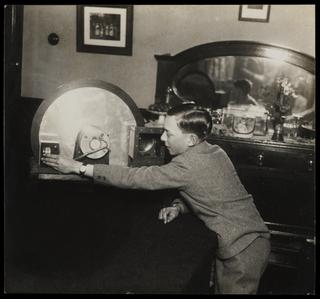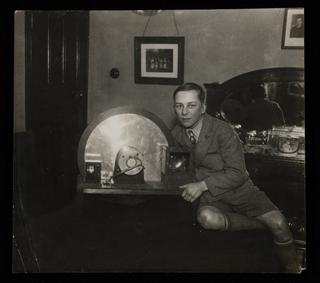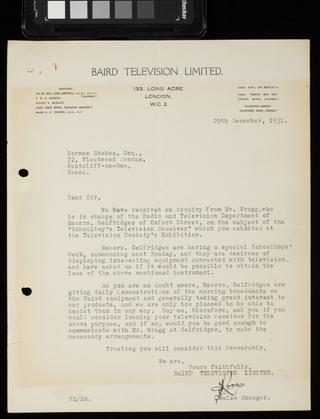
Norman Christopher Stokes 1916 - 1991
- occupation:
- Private individual
- Nationality:
- British
- born in:
- Romford, Havering, Greater London, England, United Kingdom
Living in Southend-On-Sea, schoolchild Norman Stokes built his own working model of Baird’s televisor, aged 13/14. Newspapers reported he was a ‘bit of an invalid’ and that he did not like school because it made him ‘bilious’. He loved experimenting and was entirely self-taught – his father was described as ‘not mechanically minded’.
On 5 January 1931 he was elected a student member of the Television Society and received a membership card. He exhibited his working model at the 3rd Annual Television Society Exhibition in April 1931, which was held in the Physics Laboratory at University College, London.
The set was largely made from recycled parts, including an old car cylinder, the framework of a model train truck, wire netting, pieces of tin, wood from cigar boxes, Meccano parts, an old clockwork mechanism and a torch lens to see the experimental broadcasts. The secretary of the exhibition J.J. Denton is quoted as saying ‘The boy’s a genius’. Mr. Rowe, senior steward also said ‘He has worked entirely from articles and his grasp of television is uncanny. He is simply bursting with ideas, and although some are impractical at the moment, it is probable that he is in advance of our present knowledge.’ Norman even moved his model from its assigned place to one he thought was better within the exhibition. Unfortunately, the model did not work properly, because the college was on a higher electrical voltage.
On 30 December 1931, Mr. Wragg from Selfridge’s Radio and Television Department asked to borrow the televisor for display during “Schoolboys’ Week” in their store. They wrote requesting it in addition to a letter sent from Baird Television Ltd, dated 29 December 1931, also requesting the model be displayed in the shop.
On Wednesday 23 March 1932, The Southend-On-Sea Observer reported that Norman Stokes displayed the television as part of an exhibition of hobbies at his school, Glen Dale College for Boys. It did not win first place, which was taken by a car made of Meccano, but was mentioned as being the work of a 15 year old, and the result of four years experimental work.
1939 census lists Norman (23) as still living with his parents and working as a scientific electrical apparatus-maker.
No military record could be found, but there is a possibility that Stokes could have been kept on at his job because electrical engineering was a reserved occupation.
Married in April 1946 in Chelmsford to Margaret E. Clay. Marconi and Cromptons Electrical Engineering were both based in Chelmsford, along with other smaller electrical engineering firms, so it is possible that Stokes worked for one of them.
Norman Stokes died 20 April 1991 in Chelmsford, Essex.



